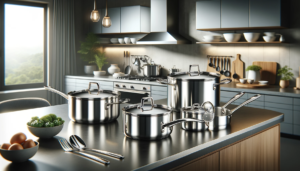Have you noticed cloudy spots, streaks or white residue building up on your stainless steel pots and pans? If so, hard water is likely the culprit.
Calcium and mineral deposits from tap water can adhere to stainless steel cookware used for boiling, simmering and cooking over time.
While hard water staining affects appearance and performance, removing built-up calcium carbonate is straightforward with the right cleaning solutions and methods.
Let’s dive into understanding why calcium adheres to stainless steel, prevention tips, effective removal techniques using household ingredients, and maintenance best practices.
How to Clean Calcium Buildup from Stainless Steel Cookware?
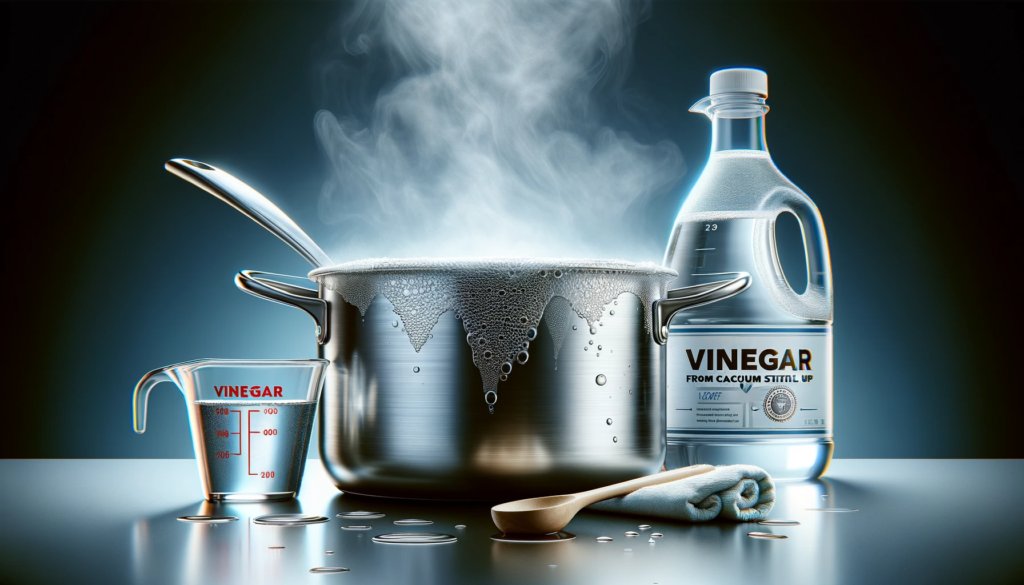
To clean calcium deposits from stainless steel pots and pans, there a few effective household cleaners that dissolve mineral buildup for removal.
The top methods are: soaking in distilled white vinegar diluted with hot water, scrubbing with a baking soda paste, using fresh lemon juice and salt to create a fizzing reaction on stains, or dissolving citric acid powder into warm water to soak affected cookware before lightly scrubbing.
Each ingredient works well through direct application to problem areas followed by light scrubbing using a soft sponge, plastic scraper, or microfiber cloth.
Below we will explore why calcium and mineral deposits occur on stainless steel along with these effective cleaning processes in further detail.
But first, let’s start with this direct overview on precise removal techniques using common household products.
Why Calcium Buildup Happens

Hard water contains dissolved minerals like calcium and magnesium.
Over time, these minerals leave deposits on surfaces they come in contact with.
Stainless steel cookware is especially vulnerable to calcium and mineral buildup from hard water.
When you regularly cook with hard tap water, calcium carbonate and other minerals adhere to the cookware surface.
These deposits leave cloudy spots, streaks, and whitish residue on pots and pans.
Calcium buildup affects the appearance and performance of stainless steel over time.
Pans become difficult to clean and may not conduct heat as evenly.
Knowing how to remove calcium from stainless steel cookware is important for maintaining its look and function.
Prevention Tips

While there are methods for removing existing calcium deposits from stainless steel, prevention is ideal to avoid buildup in the first place.
There are a few simple habits you can practice to help minimize mineral deposits on your cookware.
Use Filtered or Distilled Water for Cooking
One of the best ways to prevent calcium and mineral buildup is to avoid hard water when cooking.
Instead of regular tap water, use filtered or distilled water.
This removes minerals like calcium and magnesium, preventing them from being left behind on cookware surfaces during heating or simmering.
It’s an easy solution that saves the hassle of scrubbing mineral stains later.
Wipe Cookware Dry After Washing
After washing pots and pans, don’t leave them sitting wet in the sink or dish rack.
Dry stainless steel cookware thoroughly with a soft towel.
Allowing water droplets to air dry on the metal surface leads to visible water spots over time as the minerals in the water are deposited.
Getting in the habit of hand drying immediately after washing helps prevent calcium and mineral residue.
Use Cookware Regularly
Don’t let that stainless steel pot or pan sit unused for months at a time.
Calcium and mineral deposits build up faster on cookware that sits idle.
Using pots and pans regularly prevents the accumulation of mineral residue from water or food.
For seldom-used extra pieces, give them an occasional soak and scrub to keep them looking shiny and new.
Active use is the best practice.
Cleaning Methods
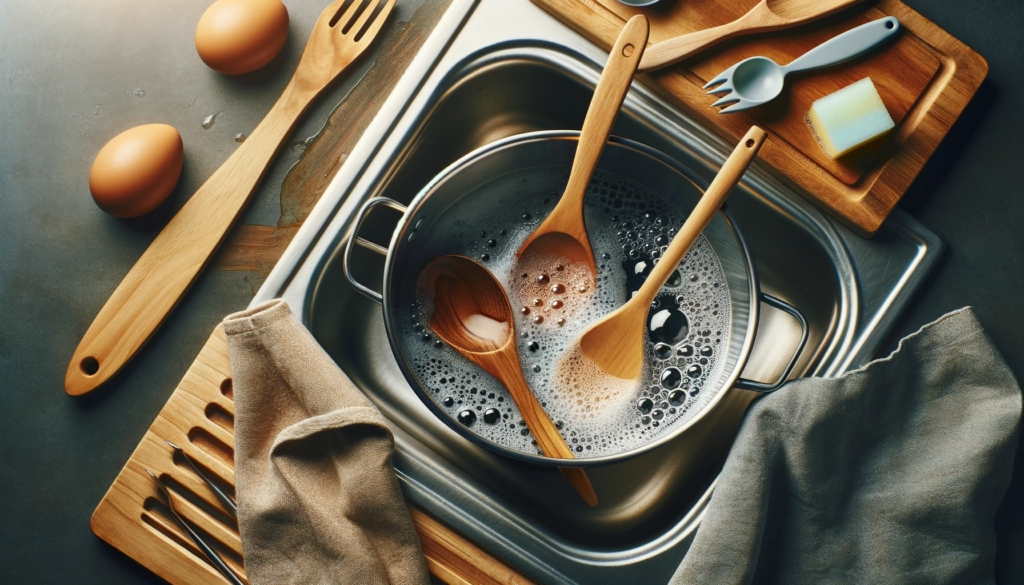
If you notice cloudiness, streaking, or white/yellow spots on your stainless steel cookware, it means calcium and mineral deposits have built up from hard water exposure.
Removing the existing calcium calls for acidic cleaners that dissolve mineral deposits.
There are several effective methods and ingredients for getting pots and pans looking clean and bright again.
Vinegar
White distilled vinegar is the go-to solution for dissolving calcium carbonate and water mineral deposits on stainless steel.
The acetic acid in vinegar breaks down mineral buildup so it can be scrubbed away with ease.
To use vinegar, bring a pot of water to a boil.
Then remove from heat and add one cup of vinegar.
Place the affected cookware into the hot vinegar solution to soak for at least one hour.
This allows the vinegar time to react with the calcium and loosen deposits.
After soaking, scrub spots and stains with a non-abrasive scouring pad designed for stainless steel.
The combination of vinegar and light scrubbing should cause mineral deposits to lift right off.
Rinse thoroughly afterwards.
For tougher calcium stains, allow cookware to soak in the vinegar solution overnight before scrubbing.
Baking Soda
Baking soda is a versatile household staple known for its cleaning and deodorizing abilities.
When combined with water, baking soda makes a gentle but effective scrubbing paste for calcium deposits on stainless steel.
To use it, add just enough water to a few tablespoons of baking soda to form a spreadable paste.
Apply the paste to cookware with calcium buildup, focusing on the most affected areas.
Let it set for several minutes before scrubbing with a soft sponge or cloth.
The baking soda will react with the mineral deposits, helping dissolve their adhesion to the steel surface.
Rinse pots and pans thoroughly after scrubbing to prevent baking soda residue.
Avoid using abrasive scouring pads when combined with baking soda, as they can scratch steel surfaces.
Salt & Lemon Volcano
For tougher calcium deposits, try using the salt and lemon volcano cleaning method.
This solution uses acid from fresh lemon juice plus an abrasive lift from table salt.
To implement it, first sprinkle an even layer of salt directly onto the calcium mineral deposits and stains on cookware.
Next, slice a fresh lemon and place the slices evenly over the salt, ensuring the lemon makes contact with salt particles.
Then squeeze lemon juice over everything so that the salt dissolves and begins to fizz.
The salt and acid together produce a chemical reaction that helps loosen calcium adhesion on stainless steel.
Allow the solution to fizz for 5 minutes before scrubbing away.
Use a soft sponge or cloth to gently scrub the area in a circular motion.
Give the cookware a thorough rinse afterwards.
Avoid using coarse salt or abrasive pads which can cause unnecessary scratching on stainless steel surfaces.
For severely stubborn calcium deposits, the volcano process may need to be applied multiple times.
Citric Acid
Citric acid is an organic powder derived from citrus fruits that cuts through mineral deposits, soap scum, hard water stains, and calcium buildup.
It’s often sold as a flavor-free additive for food and cleaners.
When it comes to removing calcium deposits from stainless steel pots and pans, citric acid is a useful solution.
To use it, mix one teaspoon of citric acid per one cup of warm water until fully dissolved.
Submerge affected cookware into the solution and allow it soak for at least 20-30 minutes.
This gives the citric acid time to react with the calcium to dissolve its adhesion.
After soaking, use a soft sponge or cloth to gently scrub away any leftover hard water marks or stains.
Give the cookware a thorough rinse afterwards since citric acid residue can leave behind a sticky feeling if not washed off entirely.
Citric acid is biodegradable and far less toxic than other acidic cleaners, making it a smart eco-friendly option for calcium removal.
Tips for Preventing Scratches
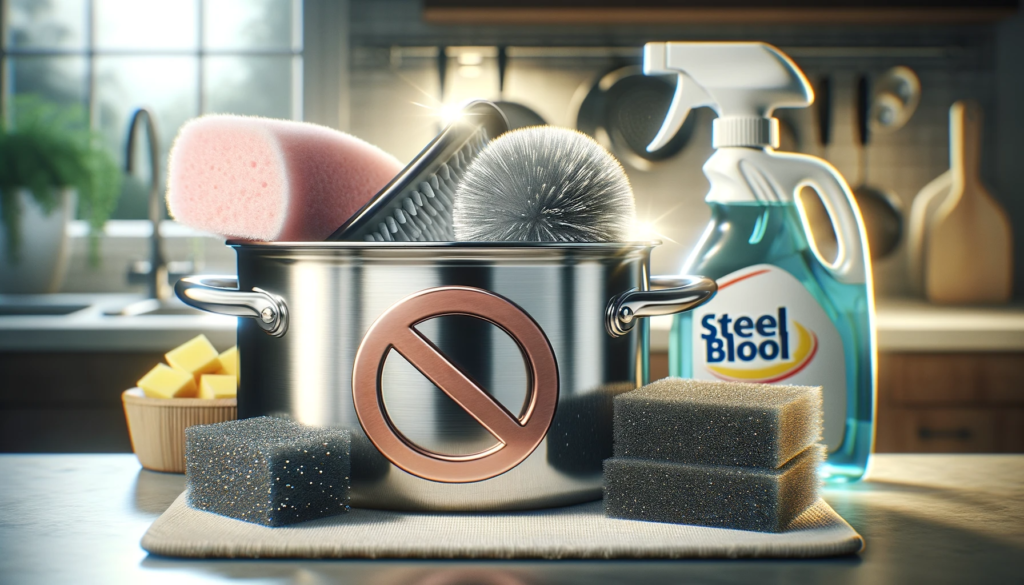
While cleaning calcium deposits, take care to avoid scratching or damaging the stainless steel surface.
Here are some tips:
Use Non-Abrasive Cleaning Tools
Avoid using steel wool, abrasive scrubbing pads, or brushes that could scratch the stainless steel.
Opt for soft sponges, microfiber cloths, or plastic scrubbers labeled safe for non-stick pans.
Check cleaning tool packaging to verify it’s non-abrasive.
Don’t Use Chlorine Bleach
While bleach cleans, removes stains, and disinfects, it can pit and corrode stainless steel surfaces with prolonged exposure.
Avoid using bleach-based cleaners which can damage the protective finish.
Clean With the Grain
Pay attention to the direction of the grain on stainless steel cookware.
When scrubbing deposits, go with the grain rather than against it to prevent fine scratches.
Rinse Thoroughly
After cleaning with any acidic solutions, rinse thoroughly with clean water.
Soap residue and acidic cleaners left drying on the surface leads to further mineral staining over time.
When to Seek Professional Help
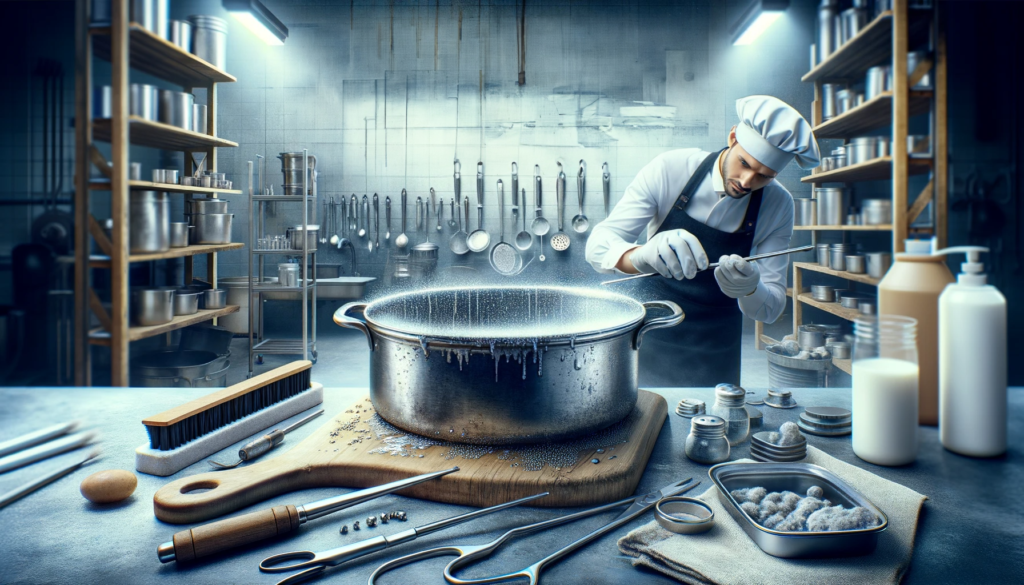
For cookware with significant calcium deposit buildup that won’t budge with home cleaning methods, professional restoration may be needed.
Many body shops that detail vehicles also service and polish metal cookware.
They have commercial descaling solutions and tools that remove stubborn mineral deposits without harming stainless steel finish quality.
This service isn’t cheap, so only utilize it if truly needed for valuable cookware beyond standard cleaning.
Maintaining Your Stainless Steel Cookware
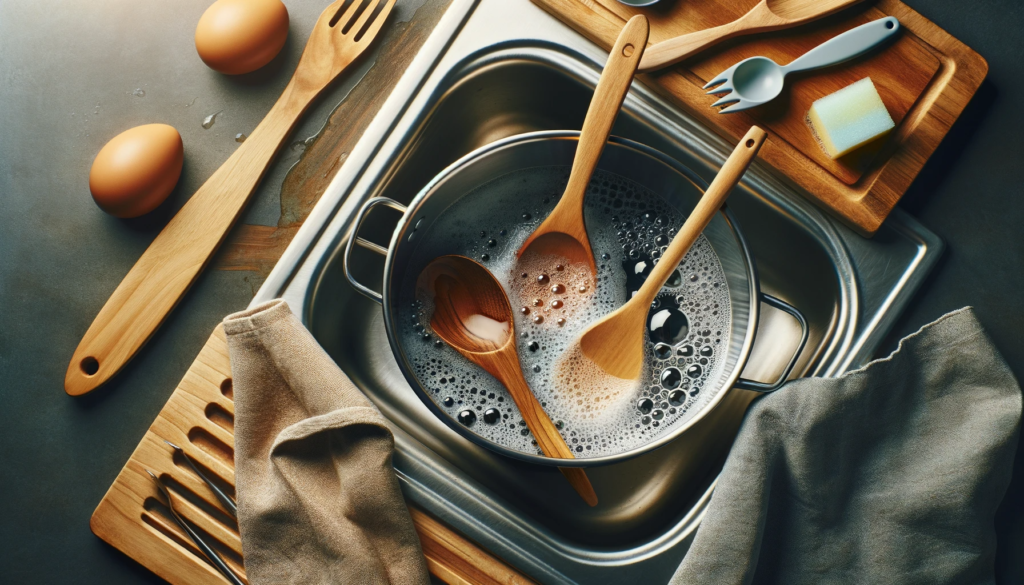
Regular cleaning and proper care keeps stainless steel cookware shining like new for years.
Along with preventing calcium and mineral deposits, there are some other easy ways to care for pots and pans:
Wash Regularly
Don’t allow food residue or grime to build up.
Use warm soapy water to wash cookware after each use.
For baked-on residue, let pans soak before scrubbing.
Dry Thoroughly
Always hand dry stainless steel cookware to prevent water spots, especially along the bottom where it meets the counter.
Use Non-Corrosive Utensils
Avoid cutlery that could scratch.
Use wood, silicone or plastic utensils when cooking instead of abrasive metal.
Remove Food Promptly
Don’t allow foods with high salt, acid, or starch content to sit in cookware.
Promptly remove or soak pans used for pasta, eggs, tomatoes, etc.
Following these tips keeps stainless steel free of damage, stains, and stuck-on debris while making cleaning easier.
Conclusion
Hard water leads to eventual calcium and mineral deposit buildup on stainless steel cookware used for cooking and simmering.
While unsightly and problematic, removing calcium carbonate staining is straightforward with the right cleaning solutions.
Vinegar, baking soda, lemon juice, and citric acid all help safely dissolve and lift mineral buildup without damaging the stainless steel surface below when used properly.
Implementing preventative measures like using filtered water and drying cookware thoroughly after washing also helps minimize calcium and other hard water stains over time.
With the proper care, cleaning, and maintenance, stainless steel cookware will provide long-lasting beauty and performance.

